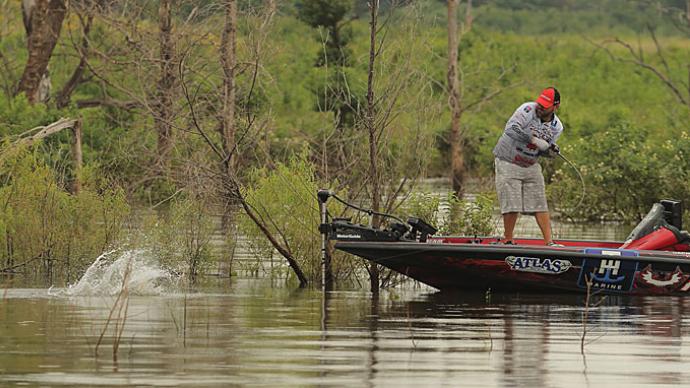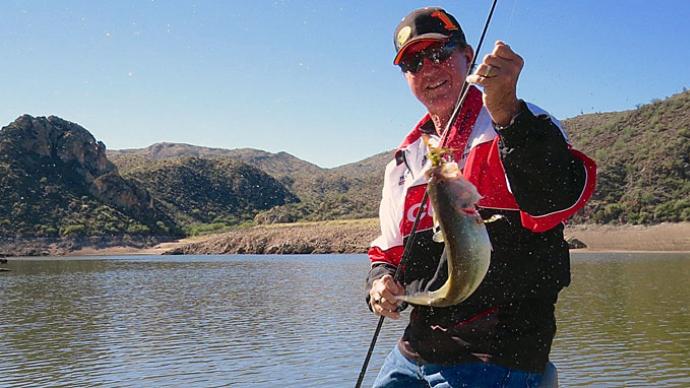
The annual reservoir drawdown works to touring pro James Watson’s advantage whether he’s fishing at home or on the tournament trail.
Every year dam authorities--whether it’s the Tennessee Valley Authority (TVA), Army Corps of Engineers, or private power companies--draw down a reservoir’s water level in the fall or winter in preparation for the flood season. Lowering the lake level provides room for the impoundment to hold runoff produced by winter or spring storms.
Watson never recalls having a lousy experience fishing a reservoir drawdown and instead reaps the benefits of the dropping lake level. “You get to see stuff you are not normally used to, like really good rock formations or seams, stump fields or little choke points,” he says. “It also helps you pattern fish on a drawdown. When the drawdown is done, the bass are positioned well in particular long branches or longer creeks.”
A drawdown eliminates shoreline bushes and other shallow hideouts for bass, but Watson believes the dropping water level concentrates bass better on particular targets in certain areas. “There is less water for them to hide in; their pond just got smaller,” he says.
“I love to see the lake come down, especially in the fall because it seems to stir up the big gizzard shad,” Watson says. “That is their normal time to get up on the bank and start running around.”
The Major League Fishing pro notices that a drawdown rate affects bass. He prefers a steady drawdown rather than a drastic drop in the lake level, such as during the spring when lake levels fluctuate up and down.
Watson will look for rain runoff areas if heavy rains occur during a drawdown. He believes runoffs are more productive in the spring, but the spots are still worth trying in the fall drawdown. “You can follow the water back up again,” he says. “That is easier to do than following the water down faster.”
Water clarity determines which part of a lake Watson keys on during the drawdown. Although bass will remain shallower in murky water, Watson prefers clear water when the water is still warm during the drawdown because it allows him to catch bass on topwater lures such as a buzz bait and River2Seas Whopper Plopper.
Catching bass during the drawdown can be broken down into three stages: beginning, middle, and end. Here’s how Watson catches bass during each stage.
Beginning stage
During the early drawdown, Watson targets rocks because the cover is abundant on all the lakes (Table Rock, Beaver, and Bull Shoals) near his home. “It is hard to beat rock,” he says. Watson finds bass in the shallows chasing shad and sunfish along the rocky banks.

The Missouri angler keyed on rocks during his victory at the October 2016 FLW Tour event on Norris Lake when the water was dropping. While other competitors ran up the river, Watson stayed in the mid-lake area, where he found a rock formation exposed by the dropping lake level. He threw a War Eagle Buzz Toad, and Whopper Plopper to catch his fish throughout the three-day tournament.
The shad migration in autumn draws Watson to the backs of creeks during the drawdown. “The shad always migrate to the back of the creeks even if the water is coming out,” Watson says.
Watson’s favorite lures to throw when bass chase large gizzard shad and perch are a 3/8-ounce War Eagle Buzz Baits, Whopper Plopper, and Big Bite Baits Suicide Shad Buzzbait. He prefers these lures because the baits match the size of the forage fish on the rocks. Watson positions his boat parallel to the bank to run his lures in the shallows throughout his retrieve.
Middle stage
When the water cools down, and the gizzard shad leave the bank, bass move out to stage in the cedar trees and pole timber or around boat docks on Watson’s home waters. “Those bass will still tend to roam up and down the bank a little bit but also drift out and suspend out there in water over 10 to 15 feet deep,” Watson says. Shad are moving out of the backs of the creeks then, so Watson starts following the batfish out to the main lake.
Bass start feeding on smaller shad during this stage, so Watson downsizes the blades on his spinnerbait. He moves his boat to the trees and casts straight to the bank instead of paralleling the shoreline. Bass will be suspended in the trees or open water, so Watson tempts them by waking the spinnerbait on the surface or throwing an Alabama rig loaded with swimbaits.
Ending stage
The spinnerbait and buzz bait continue to produce for Watson during this stage until the water temperature drops below 52 degrees. Then he switches to a Luck “E” Strike G5 crankbait that he throws to the bank and runs out to his boat sitting over depths of 12 to 15 feet. As the water temperature drops, Watson looks for the deepest docks he can find and relies on a spoon or heavy football jig to catch bass at the end of the drawdown.
BassResource may receive a portion of revenues if you make a purchase using a link above.




